Vinnytsia
Vinnytsia or Vinnytsya, or Vinnitsa (/ˈvɪnɪts(j)ə, ˈviːn-/ VIN-it-s(y)ə, VEEN-; Ukrainian: Вінниця, romanized: Vinnycja, IPA: [ˈwinːɪtsʲɐ] (![]()
Vinnytsia Вінниця Vinnitsa | |
|---|---|
| Ukrainian transcription(s) | |
| • National | Vinnytsia |
| • ALA-LC | Vinnytsi͡a |
| • BGN/PCGN | Vinnytsya |
| • Scholarly | Vinnycja |
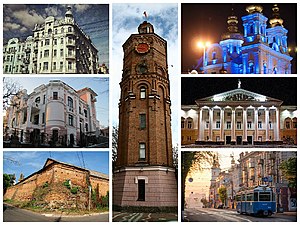 | |
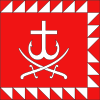 Flag  Coat of arms | |
| Nickname(s): pearl of Podilia | |
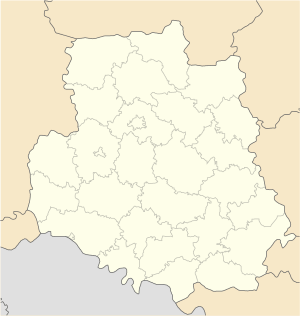 Vinnytsia  Vinnytsia | |
| Coordinates: 49°14′N 28°29′E | |
| Country | |
| Oblast | |
| Raion | Vinnytsia City Municipality |
| Founded | 1363 |
| Government | |
| • Mayor | Serhiy Morhunov |
| Area | |
| • City of regional significance | 113,2 km2 (437 sq mi) |
| Population (2015)[1] | |
| • City of regional significance | 372,484 |
| • Density | 1,066/km2 (2,760/sq mi) |
| • Metro | 660,000 |
| Time zones | UTC+2 |
| UTC+3 | |
| Postal code | 21000- |
| Area code(s) | +380 432 |
| Sister cities | Birmingham, Kielce, Peterborough, Rîbnița |
| Website | vmr |
It is the administrative center of Vinnytsia Oblast and the largest city in the historic region of Podillia. Administratively, it is incorporated as a town of oblast significance. It also serves as an administrative center of Vinnytsia Raion, one of the 27 districts of Vinnytsia Oblast, though it is not a part of the district. Population: 372,484 (2015 est.)[1]
The city's roots date back to the Middle Ages and it was under Polish control for centuries until the Russian Empire annexed it in 1793. During 1930s and early 1940s the city was the site of massacres, first during Stalin's purges and then during the Holocaust in Ukraine and the Nazi occupation. A Cold War-era airbase was located near the city.
Name
The name of Vinnytsia appeared for the first time in 1363. It is assumed that the name is derived from the old Slavic word "Vino", meaning "bride price." This name can be explained by the fact that Vinnytsia and the surrounding land were captured by Lithuanian Duke Algirdas in the 14th century, and then, they were given as a gift to his nephews.[2]
Geography
Location
Vinnytsia is located about 260 km (160 mi) southwest of the Ukrainian capital, Kyiv, 429 km (267 mi) north-northwest of the Black Sea port city of Odessa, and 369 km (229 mi) east of Lviv.
It is the administrative center of the Vinnytsia Oblast (province), as well as the administrative center of the surrounding Vinnytsia Raion (district) within the oblast. The city itself is directly subordinated to the oblast.
Climate
The town has a warm-summer humid continental climate (Köppen: Dfb), similar to northern Pennsylvania however with the precipitation of the Great Plains, summers are warm, hardly hot and humid and winters are cold.[3][4]
A long lasting warm summer with a sufficient quantity of moisture and a comparatively short winter is characteristic of Vinnytsia. The average temperature in January is −5.8 °C (21.6 °F) and 18.3 °C (64.9 °F) in July. The average annual precipitation is 638 mm (25 in).
Over the course of a year there are around 6–9 days when snowstorms occur, 37–60 days when mists occur during the cold period, and 3–5 days when thunderstorms with hail occur.
| Climate data for Vinnytsia, Ukraine (1981–2010, extremes 1936–present) | |||||||||||||
|---|---|---|---|---|---|---|---|---|---|---|---|---|---|
| Month | Jan | Feb | Mar | Apr | May | Jun | Jul | Aug | Sep | Oct | Nov | Dec | Year |
| Record high °C (°F) | 11.6 (52.9) |
17.3 (63.1) |
22.3 (72.1) |
29.4 (84.9) |
32.2 (90.0) |
35.0 (95.0) |
37.8 (100.0) |
37.3 (99.1) |
36.5 (97.7) |
28.6 (83.5) |
19.9 (67.8) |
15.4 (59.7) |
37.8 (100.0) |
| Average high °C (°F) | −1.4 (29.5) |
−0.3 (31.5) |
5.1 (41.2) |
13.4 (56.1) |
20.1 (68.2) |
22.7 (72.9) |
24.8 (76.6) |
24.3 (75.7) |
18.7 (65.7) |
12.4 (54.3) |
4.7 (40.5) |
−0.4 (31.3) |
12.0 (53.6) |
| Daily mean °C (°F) | −4.1 (24.6) |
−3.3 (26.1) |
1.2 (34.2) |
8.3 (46.9) |
14.5 (58.1) |
17.4 (63.3) |
19.2 (66.6) |
18.6 (65.5) |
13.4 (56.1) |
7.8 (46.0) |
1.7 (35.1) |
−2.8 (27.0) |
7.7 (45.9) |
| Average low °C (°F) | −6.7 (19.9) |
−6.1 (21.0) |
−2.2 (28.0) |
3.7 (38.7) |
9.1 (48.4) |
12.3 (54.1) |
14.1 (57.4) |
13.4 (56.1) |
8.9 (48.0) |
4.0 (39.2) |
−0.8 (30.6) |
−5.2 (22.6) |
3.7 (38.7) |
| Record low °C (°F) | −35.5 (−31.9) |
−33.6 (−28.5) |
−24.2 (−11.6) |
−12.7 (9.1) |
−2.8 (27.0) |
2.5 (36.5) |
5.2 (41.4) |
1.5 (34.7) |
−4.5 (23.9) |
−11.4 (11.5) |
−24.6 (−12.3) |
−27.2 (−17.0) |
−35.5 (−31.9) |
| Average precipitation mm (inches) | 29 (1.1) |
28 (1.1) |
30 (1.2) |
45 (1.8) |
50 (2.0) |
94 (3.7) |
83 (3.3) |
67 (2.6) |
63 (2.5) |
30 (1.2) |
37 (1.5) |
35 (1.4) |
590 (23.2) |
| Average rainy days | 7 | 6 | 10 | 13 | 14 | 15 | 15 | 10 | 12 | 11 | 12 | 9 | 134 |
| Average snowy days | 16 | 16 | 11 | 3 | 0.1 | 0 | 0 | 0 | 0 | 1 | 8 | 14 | 69 |
| Average relative humidity (%) | 85 | 83 | 78 | 68 | 66 | 72 | 72 | 71 | 76 | 80 | 86 | 88 | 77 |
| Mean monthly sunshine hours | 58 | 70 | 114 | 171 | 248 | 255 | 267 | 261 | 194 | 132 | 58 | 41 | 1,869 |
| Source 1: Pogoda.ru.net[5] | |||||||||||||
| Source 2: NOAA (sun only 1961–1990)[6] | |||||||||||||
History
From Medieval to Early Modern period
![]()
![]()
![]()
![]()
![]()
![]()
![]()
![]()
Vinnytsia has been an important trade and political center since the fourteenth century, when Fiodor Koriatowicz, the nephew of the Lithuanian Duke Algirdas, built a fortress (1363) against Tatar raiders on the banks of the Southern Bug. The original settlement was built and populated by Aleksander Hrehorovicz Jelec, hetman under Lithuanian Prince Švitrigaila. Aleksander Jelec built the fort, which he commanded as starosta afterwards.
In the 15th century, Lithuanian Grand Duke Alexander Jagiellon granted Winnica Magdeburg city rights. In 1566, it became part of the Bracław Voivodeship. Between 1569 and 1793 the town was a part of Poland and in this period, for a short time between 1672 and 1699 was a part of the Ottoman Empire. During period of Polish rule, Winnica was a Polish royal city. On 18 March 1783, Antoni Protazy Potocki opened in Winnica the Trade Company Poland.
After Second Partition of Poland in 1793 the Russian Empire annexed the city and the region. Russia moved to expunge the Roman Catholic religion – Catholic churches in the city (including what is now the Transfiguration Cathedral) were converted to Russian Orthodox churches.
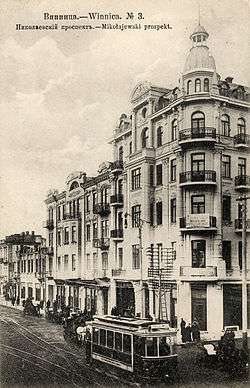
According to the Russian census of 1897, Vinnytsia with a population of 30,563 was the third largest city of Podolia after Kamianets-Podilskyi and Uman.
World War II
Vinnytsia was occupied by German troops on 19 July 1941 during World War II. In 1943, the Germans exhumed 9,439 bodies, mostly male and ethnically Ukrainian, from mass graves to discredit Soviet Communist government claims that men had been sent to prison and not executed. The majority of the executions were believed to have happened during the Stalinist Great Purge between 1937–1938 in the Vinnytsia massacre.
Adolf Hitler sited his eastern headquarters, Führerhauptquartier Werwolf or Wehrwolf, at the Wehrmacht headquarters[7] near the town; the complex was built in 1941-1942 by Russian prisoners of war; many of them were subsequently killed.[8] Hitler's accommodation consisted of a log cabin built around a private courtyard with its own concrete bunker[9] but the complex included about 20 other log buildings, a power generating station, gardens, wells, three bunkers, a swimming pool, and wire; it was surrounded by defensive positions.[10] Hitler spent a number of weeks at Wehrwolf in 1942 and early 1943.[11] The few remains of the Wehrwolf site (described by one report as a "pile of concrete" because it was destroyed by the Nazis in 1944),[12] can be visited but plans to create a full-fledged museum had not come to fruition as of August 2018.[13][14]
Nazi atrocities were committed in and near Vinnytsia by Einsatzgruppe C. Estimates of the number of victims often run as high as 28,000 although historian Oliver Rathkolb states that 35,000 Jews were deported from the Vinnytsia region and most of those later died.[7]
In 1942 a large part of the Jewish quarter of Yerusalimka was destroyed by Germans. One infamous photo, The Last Jew of Vinnytsia, shows a member of Einsatzgruppe D about to execute a Jewish man kneeling before a mass grave.[15] The text The Last Jew of Vinnytsia was written on the back of the photograph, which was found in a photo album belonging to a German soldier. It was captured by the Red Army on 20 March 1944.
Cold War period
Since the end of World War II, Vinnytsia has been the home for major Soviet Air Forces base, including an airfield, a hospital, arsenals, and other military installations. The headquarters of the 43rd Rocket Army of the Strategic Rocket Forces was stationed in Vinnytsia from 1960 to the early 1990s.[16] The 2nd Independent Heavy Bomber Aviation Corps, which later became 24th Air Army, was also stationed in Vinnytsia from 1960 to 1992. The Ukrainian Air Force Command has been based in Vinnytsia since 1992.
Education
There are many educational universities and research institutions in Vinnytsia:
- Vinnytsia Institute of Economics and Social Sciences
- Vinnytsia National Medical University. N. I. Pirogov
- Vinnytsia National Technical University
- Vinnytsia State Pedagogical University, named after Mykhailo Kotsiubynsky;
- Vinnytsia National Agrarian University
- Vinnytsia European University
- Vinnytsia Trade and Economics Institute
- Vinnytsia Social Economical Institute
- Donetsk National University, evacuated from Donetsk in 2014 due to armed conflict on the East part of Ukraine
There is also the Regional Universal Scientific Library named after Kliment Timiryazev in Vinnytsia.
Economy
Vinnytsia is an industrial center in Ukraine.
There are the Roshen confectionery corporation, the Crystal diamond polishing corporation,[17] RPC Fort largest Ukrainian firearms manufacturing corporation, Analog corporation,[18] Mayak corporation,[19] Budmash corporation,[20] Agregat corporation,[21] Pnevmatika corporation,[22] PlasmaTec corporation[23] etc.
The headquarters of the Ukrainian Air Force is situated in Vinnytsia.
Politics
Vinnytsia is considered the long-time political base for Ukrainian oligarch and former President Petro Poroshenko. He owns a local confectionery (as part of the Roshen Corporation) and was elected member of parliament from the local constituency for several convocations. However, contrary to some speculations, Poroshenko has never lived in the city.
The former Ukrainian Prime Minister Volodymyr Groysman is from Vinnytsia.
Parks and squares
Central urban park in Vinnytsia
Park of Culture and Rest named after Maxim Gorky located in Vinnytsia city - between the streets of the Cathedral (center), May Day and Khmelnytsky highway.
The park is 40 hectares.
In the park there are numerous monuments (Gorky at the main entrance, soldiers in Afghanistan, Sich Riflemen, killed police officers), and "Walk illustrious countrymen" are objects of leisure and recreation: a concert hall "Rainbow", a summer theater, stadium, ice club, city planetarium, numerous attractions and gaming machines.
For more than 70 years history of the park has always been a place of celebration as the general public and local/municipal events and holidays. Fine tradition was held in the park folk festivals and holidays is particularly on City Day, Victory Day, Independence Day and more.
_NEW_ORTHODOX_CATHEDRAL_IN_CITY_OF_VINNYTSIA_STATE_OF_UKRAINE_PHOTOGRAPH_BY_VIKTOR_O_LEDENYOV_20160427.jpg)
_CONCERT_HALL_IN_CITY_OF_VINNYTSIA_STATE_OF_UKRAINE_PHOTOGRAPH_BY_VIKTOR_O_LEDENYOV_20160427.jpg)
_UKRAINIAN_AVIATION_MONUMENT_NEAR_CONCERT_HALL_IN_CITY_OF_VINNYTSIA_STATE_OF_UKRAINE_PHOTOGRAPH_BY_VIKTOR_O_LEDENYOV_20160427.jpg)
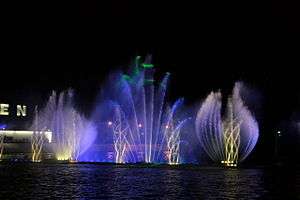
Buildings and structures
- The Transfiguration Cathedral, built in Vinnytsia in 1758.
- The new Greek Catholic Church at South Bug river.
- Baptist Church – reportedly one of the largest Evangelical Church Buildings in Europe.
- TV Tower Vinnytsia
- Vaksman family's real estate, 1915 – Style: Art Nouveau. Address: 24 Chkalov Street. Built by architect Moisey Aaronovitch Vaksman. Architectural landmark.
- Afghan War Museum and War Glory Memorial Park – The Afghan War Museum is located in the red-brick bell tower. Exhibits include photos, letters and other artifacts representing Vinnytsia soldiers who fought in that war. The Memorial Park contains a large statue representing three different soldiers from World War II. An eternal flame burns in front of the statue.
- Multimedia Fountain Roshen – Built in 2011 it is considered as one of the largest floating fountains in Europe.[26] It is the major multimedia attraction in the city.
- The Literary and Memorial Museum of the “great sun-lover”, classical author of Ukrainian literature M.M.Kotsyubynsky, is very popular among local inhabitants and guests; it is also a place of development for creative youth. In the city, numerous historical buildings are being repaired and new ones are being built.
- The national Pirogov's estate museum
Transport
Air
Havryshivka Vinnytsia International Airport (IATA: VIN, ICAO: UKWW) is situated near Vinnytsia.
Railway
There is a railway station in Vinnytsia, which is a part of 'South-Western Railway'. In 2013 it was named among 10 biggest railway stations in Ukraine[27] Current building of Vinnytsia railway station was built in 1952 and considered to be the 4th railway building in Vinnytsia (previous three were destroyed in different years). Vinnytsia is an important transport point, both for internal and external railway connection. Most of the international trains, which cross through Ukraine, have a stop in Vinnytsia. For example, trains from Moscow and Saint Petersburg (Russia), Minsk (Belarus), Sofia (Bulgaria), Chisinau (Moldova), Bratislava (Slovakia), Belgrade (Serbia), Budapest (Hungary) transit through Vinnytsia.[27] In internal railiway connection, Vinnytsia is also an important transport point for trains, heading to Western Ukraine (Lviv, Khmelnytskyi, Chernivtsi) and to South (Odessa), as well as to Central Ukraine (Kiev).
_RAILWAY_STATION_IN_CITY_OF_VINNYTSIA_STATE_OF_UKRAINE_PHOTOGRAPH_BY_VIKTOR_O_LEDENYOV_20160427.jpg)
Tram
The tram is the most popular public transport in Vinnytsia. There are six tram routes in Vinnytsia (1,2,3,4,5,6).[28]
| Number of the route | Route starting and ending point |
|---|---|
| 1 | The railway station (Zaliznychnyi vokzal) - Elektromerezha. |
| 2 | Barske Shose - Vyshynka |
| 3 | Vyshynka - Electromerezha |
| 4 | Barske Shose - the Railway station (Zaliznychnyi vokzal) |
| 5 | Barske Shose - Elektromerezha |
| 6 | The railway station (Zaliznychnyi vokzal) - Vyshynka. |
There are a lot of trams in Vinnytsia. The newest ones (blue trams) are from Switzerland.
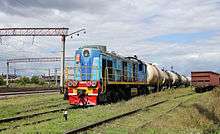
Notable people
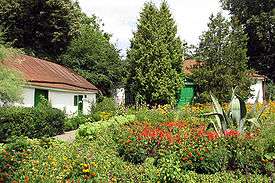
- Nathan Altman (1889–1970) – avant-garde artist
- Sam Born (1891-1959) - confectioner
- Mykhailo Kotsiubynsky (1864–1913) – Ukrainian author of novels and short stories. His home is a museum.
- Mykola Leontovych (1877–1921) – Ukrainian composer who worked here
- Alexander Lerner (1913–2004) – Soviet-Israeli cyberneticist and dissident
- Yuri Levada (1930–2006) – sociologist, political scientist and the founder of the Levada Center
- Jerzy Niezbrzycki (1902–1968) – captain of the Polish Army
- Nikolai Pirogov (1810–1881) – originally from Moscow, this Imperial Russian doctor, considered to be the founder of field surgery, spent the later years of his life in Vinnytsia. His home is a museum and his chapel tomb is open to visitors.
- Maksym Shapoval (1978–2017) – Senior intelligence officer and head of a special forces detachment unit of the Ukrainian Chief Directorate of Intelligence. Assassinated by Russian agents in 2017.
- Marina (b.1989) - Polish singer of Ukrainian origin
- Olga Storozhenko (b.1992) Miss Ukraine Universe 2013 & Top 10 Miss Universe 2013
International relations
Gallery
 Vinnytsia regional council
Vinnytsia regional council The main train station.
The main train station. The Transfiguration Cathedral in Vinnytsia (1758).
The Transfiguration Cathedral in Vinnytsia (1758).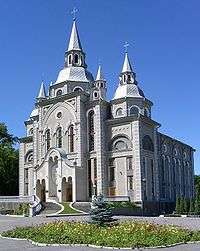 Baptist church.
Baptist church. Glory Memorial and Eternal flame.
Glory Memorial and Eternal flame. Modernist building, built by architect V.P. Listovichiy.
Modernist building, built by architect V.P. Listovichiy.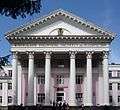 Medical University in Vinnytsia.
Medical University in Vinnytsia. State academic theater.
State academic theater.- Savoy Hotel in Vinnytsia
- City hall
- Home stadium of PFC Nyva Vinnytsia.
 ROSHEN Factory in Vinnytsia.
ROSHEN Factory in Vinnytsia.
See also
- FC Nyva Vinnytsia
- Roshen
- Fountain Roshen
- TIK
- Vinnytsia massacre
- Vinnytsia tram
- Werwolf (Wehrmacht HQ) - the codename used for one of Adolf Hitler's World War II Eastern Front military headquarters. It was one the most easterly ever used by Hitler in person.
- Harold F. Cherniss, famous American scholar, son of emigrant from Vinnytsia
- Vinnytsia Fatalities an oldschool deathcore band
References
- "Чисельність наявного населення України (Actual population of Ukraine)" (PDF) (in Ukrainian). State Statistics Service of Ukraine. Retrieved 1 July 2016.
- http://www.diclib.com/cgi-bin/d1.cgi?l=ru&base=geo_rus&page=showid&id=1223#.V1KMRE2R_IU
- "Vinnitsa Climate Vinnitsa Temperatures Vinnitsa Weather Averages". www.vinnitsa.climatemps.com. Retrieved 20 June 2019.
- "Comparison of the Average Weather in Vinnytsya and Forest City - Weather Spark". weatherspark.com. Retrieved 20 June 2019.
- "Климат Винницы" (in Russian). Weather and Climate (Погода и климат). Archived from the original on 13 December 2019. Retrieved 13 December 2019.
- "Vinnica (Vinnytsia) Climate Normals 1961–1990". National Oceanic and Atmospheric Administration. Retrieved 13 October 2015.
- Rathkolb, Oliver (1 August 2004). Revisiting the National Socialist Legacy: Coming to Terms With Forced Labor, Expropriation, Compensation, and Restitution. Transaction. p. 179. ISBN 978-0765805966.
- "Hitler's Ukrainian Bunker Revealed". BBC. 12 March 2012. Retrieved 28 August 2018.
- Felton, Mark (4 August 2014). Guarding Hitler: The Secret World of the Fuhrer. London: Pen and Sword Military. ISBN 1781593051.
- https://books.google.ca/books?id=JT1pCQAAQBAJ&pg=PA292&dq=Vinnytsia+Hitler++log+cabins&hl=en&sa=X&ved=0ahUKEwjChrLdtJDdAhUMwYMKHchBCh4Q6AEIKTAA#v=onepage&q=Vinnytsia%20Hitler%20%20log%20cabins&f=false&page=292
- Speer, Albert (1995). Inside the Third Reich. London: Weidenfeld & Nicolson. pp. 328–329. ISBN 9781842127353.
- "Hitler's headquarters "Werwolf"". The Koz Telegram. 18 August 2018. Retrieved 28 August 2018.
- "Hitler's Ukrainian Bunker Revealed". 12 March 2012. Retrieved 28 August 2018.
- "Hitler's headquarters "Werwolf"". 2018. Retrieved 28 August 2018.
- "The last Jew in Vinnytsia [1941]". World's famous photos. Archived from the original on 30 April 2010. Retrieved 26 August 2010.
- "43rd Missile Army". Ww2.dk. Retrieved 16 September 2011.
- "Інтернет магазин ювелірних виробів із золота – ціни, фото – Вінниця Кристал". vinnitsakristall.com. Retrieved 24 May 2019.
- "О НАС". zavodanalog.com. Retrieved 24 May 2019.
- "ЧАО Маяк - производитель обогревательных приборов и радиаторов для систем отопления". termia.com.ua. Retrieved 24 May 2019.
- ""БУДМАШ". Вінниця, Україна". www.budmash.vn.ua. Retrieved 24 May 2019.
- "www.vzta.com.ua". www.vzta.com.ua. Retrieved 24 May 2019.
- "Пневматика. Винница, Украина". www.pnevmatica.com.ua. Retrieved 24 May 2019.
- http://www.plasmatec-weld.com.ua/
- "The national Pirogov's estate museum". Pirogov.com.ua. Retrieved 17 July 2014.
- "About fountain :: Europe's largest floating fountain". Fountainroshen.com. Retrieved 5 January 2013.
- "Roshen Fountain in Vinnitsa was opened! :: Confectionery Corporation ROSHEN". roshen.com. Archived from the original on 10 July 2015. Retrieved 25 October 2015.
- http://cfts.org.ua/articles/desyat_krupneyshikh_zh_d_vokzalov_ukrainy_2014_goda_667/66829/
- "Розклад | Вінницький трамвай". depo.vn.ua (in Ukrainian). Retrieved 26 March 2018.
- "ВІННИЦЯ 1 табло автовокзалу: оперативна інформація автовокзалу (автостанції) про розклад руху автобусів та його зміни, наявність вільних місць.в автобусах". bus.com.ua. Retrieved 24 May 2019.
- http://avtobys.in.ua/vinnycka/vinnycja-as-2-zakhidna/
- "ВІННИЦЯ 2 табло автовокзалу: оперативна інформація автовокзалу (автостанції) про розклад руху автобусів та його зміни, наявність вільних місць.в автобусах". bus.com.ua. Retrieved 24 May 2019.
- "Vinnytsia Twin Cities".
- "Kardeş Şehirler". Bursa Büyükşehir Belediyesi Basın Koordinasyon Merkez. Tüm Hakları Saklıdır. Retrieved 27 July 2013.
External links
| Look up Vinnytsia in Wiktionary, the free dictionary. |
| Wikimedia Commons has media related to Vinnytsia. |
| Wikivoyage has a travel guide for Vinnytsya. |
- Official website (in Ukrainian and English)
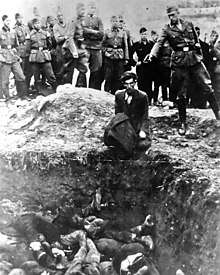
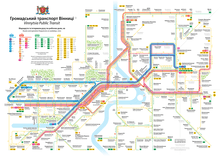
_MODERN_BUS_AT_WESTERN_BUS_STATION_IN_CITY_OF_VINNYTSIA_STATE_OF_UKRAINE_PHOTOGRAPH_BY_VIKTOR_O_LEDENYOV_20160427.jpg)